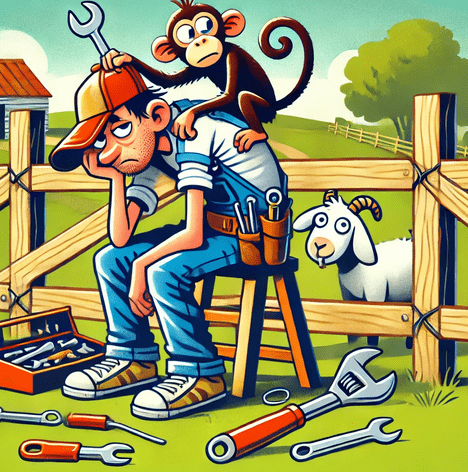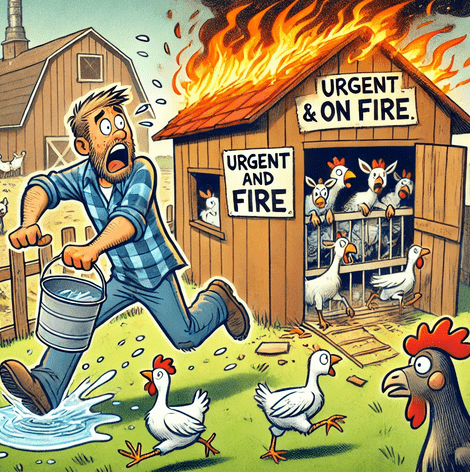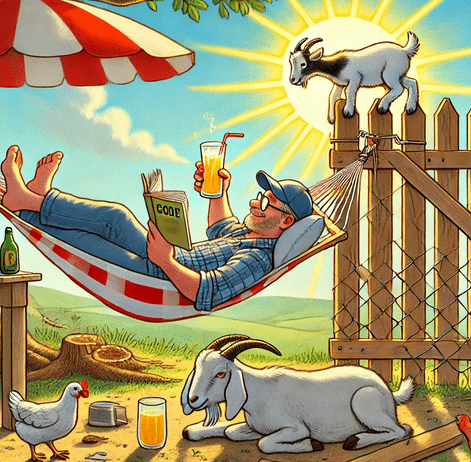The Importance of Prioritizing at the Self-Sufficient Homestead
Living on a self-sufficient homestead is like juggling flaming torches, but with goats chewing on your shoelaces for good measure. The dream of self-reliance is all about balance—balancing projects, repairs, and, yes, even some much-needed relaxation. But let’s be honest: not everything on a homestead is of equal importance. Some tasks are like rabid wolves at your door, demanding immediate attention, while others are more like pesky flies, buzzing around but not necessarily life-threatening. Let’s break down the fine art of prioritizing tasks from the “urgent” to the “I’ll get to it after my cup of coffee.”

Urgent: The Must-Do-Or-Die Tasks
First, let’s talk about those “urgent” tasks—the ones that, if left undone, could lead to a minor apocalypse on your property. Think of these as your ‘must-do-or-die’ items. If a storm blows a hole in your roof, that’s urgent. If the chicken coop is on fire, that’s urgent (also, who left the lantern too close to the hay?). Immediate repair and maintenance tasks are usually top of the list because they prevent further damage, save money in the long run, and, most importantly, keep you and your animals safe. So, before you start building that new raised bed or repainting the barn door a charming shade of red, patch up those leaks and secure those fences. Your chickens will thank you, and you’ll sleep better without the wind whistling through the walls.

Important: Projects That Advance Your Homestead
Next up are the “important but not on fire” tasks. These are your longer-term projects that push your homestead forward—building a greenhouse, installing a rainwater harvesting system, or expanding your vegetable garden. These projects are crucial because they improve the overall functionality and sustainability of your homestead. However, they require planning, time, and resources, so they typically follow right after the urgent repairs. Here’s where prioritization gets tricky: it’s easy to get sucked into a new, exciting project and forget the half-painted barn or the half-installed solar panels. The key is to balance advancing your homestead with keeping it running smoothly. Think of it like building a castle: you can’t add a new tower until the walls are standing strong.
Necessary: Regular Maintenance and Upkeep
Then there’s regular maintenance. This is the bread and butter of homestead life, the unsung hero that prevents those urgent emergencies from popping up. Cleaning the gutters, oiling the hinges, and checking on your well pump might not be glamorous, but these tasks are necessary to keep everything running smoothly. Regular maintenance is like flossing for your homestead; you could skip it, but you’ll regret it when the bigger issues start cropping up. Set aside time each week to tackle these smaller, ongoing tasks to prevent them from becoming bigger problems down the line.
Optional: Cosmetic and Convenience Projects
Now, let’s move to the “nice to have but not necessary” category. These are your cosmetic and convenience projects—painting the barn a delightful pastel color, installing a new hammock in the shade, or setting up a garden gnome village. While these projects might not be crucial to your survival, they are essential for your sanity. There’s nothing wrong with wanting to make your homestead more beautiful or more comfortable, as long as it doesn’t come at the expense of more pressing needs. Remember, a pretty homestead with a leaky roof isn’t going to impress anyone (except maybe the birds looking for a new swimming pool).
Balancing Priorities: Urgency vs. Relaxation

Finally, don’t forget to prioritize relaxation. Yes, you read that right. Taking a break is just as important as fixing the roof or planting the orchard. If you burn out, who’s going to milk the goats or tend the garden? Make sure to schedule downtime—whether that’s a quiet cup of tea, a walk in the woods, or a lazy afternoon in that hammock you finally installed. Relaxation isn’t just a luxury; it’s a necessity for maintaining the energy and enthusiasm needed to keep your homestead running smoothly.
Conclusion: The Art of Juggling with Purpose
Living on a self-sufficient homestead is a balancing act of epic proportions. It’s about knowing when to jump into action and when to take a step back. Urgent tasks keep you safe, important projects advance your self-sufficiency, and regular maintenance keeps everything running smoothly. Meanwhile, those cosmetic touches and moments of relaxation keep you sane. So, prioritize wisely, tackle your tasks with purpose, and always, always keep your sense of humor intact. After all, there’s nothing more satisfying than a well-ordered homestead… except maybe a well-ordered homestead with a freshly painted barn and a hammock in the shade.
